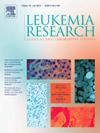The role of morphology in diagnosing MDS with Non-clonal cytopenias
IF 2.1
4区 医学
Q3 HEMATOLOGY
引用次数: 0
Abstract
Myelodysplastic syndromes/neoplasms (MDS) are a heterogeneous group of blood disorders characterized by distinctive biological and clinical features. Diagnosis typically relies on bone marrow examination and cytogenetic/molecular analysis. However, a small subset of patients lacks detectable cytogenetic or genetic abnormalities, making diagnosis challenging and reliant solely on marrow dysplasia and cytopenia. Here, we conducted a multicenter retrospective study investigating the clinical and hematological features of patients with MDS lacking detectable cytogenetic or molecular alterations. From a cohort of 329 MDS patients who underwent genetic testing at our laboratory of “Diagnostica Avanzata Oncoematologica”, we selected 62 patients presenting with unexplained cytopenia, suspected MDS, and a non-informative cytogenomic profile. Of these, 26 were ultimately diagnosed with alternative conditions such as aplastic anemia, drug/radiation toxicity, multiple myeloma, and others. The patients with non-informative genetic profile had a median age of 60 years and a female predominance (67 %). Autoimmune diseases (AD) were the most frequently observed comorbidities (26 %), and neutropenia was the most common type of cytopenia (56 %), followed by thrombocytopenia (22 %), and anemia (19 %). Most patients had bi-lineage or tri-lineage dysplasia, and had low-risk disease according to IPSS-R and IPSS-M. Only one patient progressed to AML at a median follow-up of 12 months (IQR for the test cohort: 2–25). MDS lacking classical myeloid clonal alteration represent a unique clinical-biological subtype whereby marrow assessment along with a thorough clinical workup is crucial.
形态学在诊断MDS合并非克隆性细胞减少症中的作用
骨髓增生异常综合征/肿瘤(MDS)是一组异质性血液疾病,具有独特的生物学和临床特征。诊断通常依赖于骨髓检查和细胞遗传学/分子分析。然而,一小部分患者缺乏可检测的细胞遗传学或遗传异常,这使得诊断具有挑战性,并且仅依赖于骨髓发育不良和细胞减少症。在这里,我们进行了一项多中心回顾性研究,调查缺乏可检测的细胞遗传学或分子改变的MDS患者的临床和血液学特征。在我们的“Avanzata肿瘤学诊断”实验室进行基因检测的329例MDS患者中,我们选择了62例出现不明原因的细胞减少、疑似MDS和无信息的细胞基因组谱的患者。其中,26人最终被诊断出患有再生障碍性贫血、药物/辐射毒性、多发性骨髓瘤等其他疾病。非信息性遗传谱的患者中位年龄为60岁,女性居多(67% %)。自身免疫性疾病(AD)是最常见的合并症(26% %),中性粒细胞减少症是最常见的细胞减少症(56% %),其次是血小板减少症(22% %)和贫血(19% %)。根据IPSS-R和IPSS-M,大多数患者为双系或三系发育不良,疾病风险低。在中位随访12个月时,只有1例患者进展为AML(测试队列的IQR: 2-25)。缺乏经典髓系克隆改变的MDS代表了一种独特的临床生物学亚型,因此骨髓评估以及彻底的临床检查至关重要。
本文章由计算机程序翻译,如有差异,请以英文原文为准。
求助全文
约1分钟内获得全文
求助全文
来源期刊

Leukemia research
医学-血液学
CiteScore
4.00
自引率
3.70%
发文量
259
审稿时长
1 months
期刊介绍:
Leukemia Research an international journal which brings comprehensive and current information to all health care professionals involved in basic and applied clinical research in hematological malignancies. The editors encourage the submission of articles relevant to hematological malignancies. The Journal scope includes reporting studies of cellular and molecular biology, genetics, immunology, epidemiology, clinical evaluation, and therapy of these diseases.
 求助内容:
求助内容: 应助结果提醒方式:
应助结果提醒方式:


